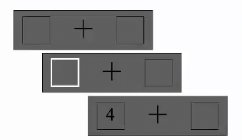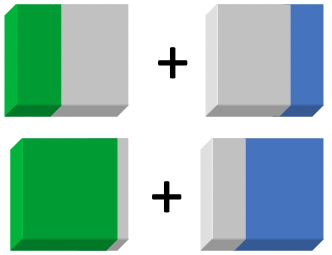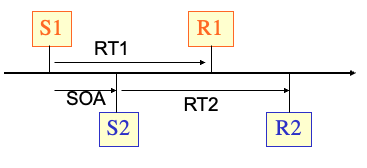cognition 6 (selective attention)
1/36
There's no tags or description
Looks like no tags are added yet.
Name | Mastery | Learn | Test | Matching | Spaced |
|---|
No study sessions yet.
37 Terms
why is attention important for memory?
incoming information → sensory memory
information will only go from sensory to short term if attention paid to it
no attention = information lost
we cannot attend to everything, so we attend to some things and not others
can we divide attention?
no, this can be demonstated by the ‘cocktail party’ effect
we cannot understand/remember the contents of two concurrent spoken messages (cherry, 1950s)
instead we alternate between attending selectively to the speakers
want to know if the bottle neck is
at the perception of speech sounds
lexical access
syntactic parsing anf semantic interpretation

how is this investigated in the lab
Moray
focus attention on one of simultaneous messages (dichotic listening task)
shadowing on of the messages is successful if messages differ in
physical properties (location, voice)
semantic content
in the unattended message, participants notice:
→ physical changes (location, voice, volume) NOT semantic changes (from meaningful to meaningless)
word repeated 35 times in unattended message not remembered better in later recognition test than word heard once
where is the bottle neck?
unattended words are filtered out, after analysis of physical attributes, before access to meaning
we are aware of unattended speech sounds (pitch, volume, phonetic characteristics) but do not process meaning
to extract identity, we have to switch attention filter between them- slow and effortful
Broadbent’s (1958) dichotic split-span experiment
→ left ear: 3, 7, 6, right ear: 9, 4, 2
easier to report as 376942 (one switch) than 397462 (switch after each digit)
broadbents filter model
sensory features of speech sources are processed in parallel and stored in sensory memory (echoic memory)
selective filter directed only to one source at a time
filter is early in processing so only information that passes through the filter can be
recognised
meaning activated
representation in memory
control of voluntary action
access to conscious awareness
additional assumptions of broadbent’s account
filter is all or none
filter is obligatory ‘structural’ bottleneck

but is filtering all or none?
examples of partial breakthrough of meaning in unattended speech in shadowing experiments
own name noticed in unattended speech (Moray)
interpretation of lexically ambiguous words in attended message influenced by meaning of words in unattended message (Lackner and Garrett)
saw port for the first time (attended) drank until bottle was empty (unattended)
another way this has been investigated
condition a galvanic skin response to the word Chicago (through mild electric shock)
galvanic skin response evoked by the word Chicago in the unattended message
participant does not remember hearing Chicago!
generalises to other city names
→ GSR to unattended weaker than to attended names
semantic activation by unattended input is attenuated, not blocked
how were theories modified
argued attentional filter after higher level processing, not before
theory:
both attended and unattended words processed up to identification and meaning activation
relevant meanings then picked out on basis of permanent salience or current relevance
but doesn’t explain:
selection on the basis of sensory attributes so much more effective than selection on basis of meaning
GSR to unattended probe words weaker than to attended
further modified theory
filter attenuation theory (Treisman, 1969)
there is an early filter but:
it is not all-or-none
it attenuates (turns down) information from unattended sources (so unattended words can still activate meanings if salient or contextually relevant)
early filtering is optional (not a fixed structural bottleneck)

experiments for this early selection option (not structural bottleneck) notion
monitoring for target word
lots of words played in let or right ear
press L or R key when animal name heard
after practice, finding the target word is equally accurate whether it's heard in one ear or both (unless selective understanding/repetition of one message is required)
→ can monitor easily in both channels, but when we have to shadow and monitor then filter has to be applied early
now we stop talking about auditory attention and move to visual attention- how we can influence where participants attended to
we can use endogenous cueing
probable stimulus location indicated by arrow cue or neutral cue (*)
participant responds as fast as possible to stimulus (maintaining central fixation)
different tasks
simple RT to onset
choice ‘spatial’ RT (left or right from centre)
choice ‘symbolic’ RT (letter/digit)
→ all faster for expected location and slower for unexpected
can voluntarily choose where to attend to
another way of cueing
exogenous
instead of endogenous (voluntary top-down), its exogenous (stimulus driven, bottom up) shifts
digit appears on left or right and one of the squares lights up
→ RT faster just after sudden onset/change at stimulus location, although does not predict stimulus location
→ timing of exogenous cueing different from endogenous
exogenous attraction of the spotlight is fast (<200 ms)
endogenous movement of spotlight takes several hundred ms

how do ERP’s link to this
voluntary attention to spatial locus modulates early components of ERP in extra-striate visual cortex
participants focus on fixation cross
cued to one of the locations and stimulus appeared
→ if stimulus appeared in attended location (big P1), stimulus in unattended = smaller P1
suggests attention helping processing of the stimulus
how early does attention work
early selection in V1 and LGN (geniculate-striate pathway)
fixation maintained on central point
series of digits appears at fixation and
high or low contrast checkerboards appear in left and right periphery
participant either counts digits at fixation or detects random luminance changes on left or right checkerboard
BOLD signal in LGN/V1 that reacts to checkerboard luminance change is greater when attention directed to that side than with attention to fixation
→ so, some selection (for regions in visual field) occurs very early in processing
overall, visual attention is
not all-or-none
an optional process
experiment as evidence:
participants had to attend to:
central letter
whole word (real or not-real word)
occasionally probe, had to classify a letter (z or 7 etc)
→ in the central letter condition, if the probe was int he centre= fast RT, probe not in the centre= slower RT
→ in the whole word condition= RT constant independent of location of the probe
how efficient is our attention
Lavie
‘flanker’ task
press left key for little X, right key for little Z on midline
ignore big letter above or below mid-line (distracting flanker)
incongruent distractor slows response, compared to congruent if processing load is low
→ this effect does not occur if participant has to pick target out of several irrelevant letters (irrelevant distractor does not distract as much)

how do we miss information
inattentional blindness (simons and chabris)
participants attend closely to one coherent stream of visual events
highly salient events in the unattended stream are missed
though happening in the visual field, information in unattended stream not processed to the level of meaning
capacity and multitasking- the limiting factors
attention
WM capacity
speed of processing
multi-tasking and cognitive capacity
there are limits to our cognitive capacity
all processes take time
there are limits to the input any process can handle (syntactic parsing)
representational/stroage capacity is limited (WM)
capacity limits become even more obvious when resources must be shared between tasks (multi-tasking)
→ limitations are important theoretically (architecture of the brain) and practically (human error- driving)
the demands of multi-tasking
when we try to do tasks simultaneously
there is competition for shared resources (dual-task interference)
when we try to switch between tasks
retrospective memory
prospective memory
demands on executive control
planning, scheduling, coordinating two task streams
trouble shooting when there is an error
multitasking is not a single competence, executive control processes are critical
example of limited capacity
using mobile phone while driving, this is illegal
hands free not illegal but:
studies show increased accidents
delayed braking at T-junction
impaired braking, detection of potential hazards
especially true for young drivers
study shows even with handsfree, cannot give full attention to driving when load is increased through the phone (50% increase in RT)
study on relative risk of mobile phone use and drinking
driver in stimulator, follows pacer car in slow lane of motorway (15 mins), tries to maintain distance, pacer brakes occasionally
baseline vs alcohol
casual talk on hand held vs hands free
→ mobile phone users: slower RT, more tail ended collisions, slower recovery
→ alcohol: more aggressive driving (closer following, harder braking)
no significant difference between hand-held vs hands-free
what do further driving stimulator studies show
hands-free
reduced anticipatory glances to safety critical locations
reduced later recognition memory of objects in driving environment
increased probability of unsafe lane change
→ actual passenger does not have the same effect, passengers sensitive to drivers load and can help to spot hazards
how can we measure dual-task interference
two tasks designed for measurement and manipulation
measures performance on:
tasks A and B alone
tasks A and B combined
does performance on each task deteriorate when the other must also be performed?
→ slower, less accurate performance in dual task conditions
why is there this slower, less accurate performance?
competition for use of specialised domain-specific resources
parts of body can only do one thing at a time
brain modules (processing certain things)
competition for use of general purpose processing capacity
central processor
pool of general process processing resource
limited capacity of executive control mechanisms that set up and manage the flow of information through the system and/or suboptimal control categories
competition for domain-specific resources
two continuous speech inputs cannot but simultaneously understood or repeated
performing a spatial tracking task interferes with use of visual imagery to remember stuff- both use visuo spatial WM
two different tasks need to use the same perceptual processes, response mechanisms, we should expect dual-task interference
→ unless info is low enough to switch us of that resource between tasks, but concurrent performance of any pair of tasks results in some interference
competition for general process processor
broadbent- there is a general purpose, limited-capacity central processing processor needed fro high level cognitive processes like
pattern identification
attention selection
decision making, planning
access to memory
→ everything goes through this for an overt action
or is it a general purpose resource pool
Kahneman (1975)
proposed a pool of general-purpose resource that is shared among concurrent tasksk (mental energy, attention and effort)
the capacity of this general purpose resource may vary:
between people
within people over states of alertness
diminish with boredom or fatigue
increases with time of day, stressors up to optimal, emotional arousal and conscious effort
if there is central processor or resource pool, whose capacity is shared by two tasks?
sum of capacity demands does not exceed available total
no interference
sum does exceed available total
interference
increasing difficulty of one task should reduce the capacity available for another task
hard to know how much capacity a given task should use, so test theory by using pairs of tasks for which it seems obvious that each would require all or most of central capacity

how was this tested
demanding tasks combined without interference
music students
task a. sight read grade 2 (easy) vs grade 4 (hard) piano pieces
task b. shadow prose from auten novel (easy) or old norse (hard)
little practice
experiment:
two sessions of 2 × 1 min dual task for each combination of easy and hard and one min sight reading or shadowing alone
findings:
→ rate of shadowing and number of shadowing errors no different with or without concurrent sight reading
→ more shadowing errors for harder text, more sight reading errors for grade 4 pieces but by session 2, not difference for difficulty levels
two more examples
tasks combined without interference
skilled visual copy-typing can be combined with shadowing prose without interference
one task insensitive to the difficulty of the other
continuous tracking and digit key task
no effect of difficulty of digit task on tracking delays
rad ass claim
there is no central general purpose processor
pairs of complex input-output translation can be combined with little or no interference if they use non-overlapping modules
→ but even when tasks use completely different modules, some interference ariss due to coordination and control demands
how does this link to driving and phone
could argue:
a. driving and navigation (visuospatial input → hand and foot responses)
b. conversation (speech input → speech production)
different modules
but both require construction of a mental model
→ when both tasks require construction of mental model then we get interference
importance of practice
tasks which cannot be combined without interference become easier to combine with practice (changing gear while driving)
example study:
85 hours of practice at
reading stories at the same time as writing to dictation
reading stories with writing category of spoken words
→ participants showed little dual-task interference and practicing automates task- reduces need for executive control
broadbents arguments
with pairs of continuous tasks like shadowing and sight reading, there is
predictability in the input (can anticipate)
lag between input and output (so must be temp storage in WM of input/output)
could still be a central processor switching between the two tasks (time sharing)
→ test: processor switching should be revealed if we use concurrent tasks with very small lags between input and output and the next stimulus is unpredictable (RT tasks)
example of this
the psychological refractory period (PRP)
welford (1952)
two choice RT tasks
stimulus onsets separated by a variable, short interval '(stimulus onset asynchrony/SOA)
findings:
RT1 always the same, uninfluenced by second
RT2 (long lag/SOA) = performance unaffected, short lag/SOA = greater RT
→ must be some central processor or we’d be able to do these two things at one time

another way of explaining this
is it the response selection that is the bottleneck (pashler’s theory)
can be performed for only one task at a time
if a second stimulus arrives and is identified, it must wait until the response selection mechanism is free
→ have to respond to first before you can respond to the next